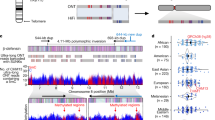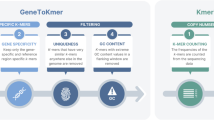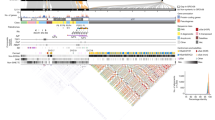Abstract
Twenty-three unique NotI-linking clones, mainly isolated from the NRL1 library, were mapped and ordered by fluorescence in situ hybridization to human chromosome 3. All these clones were partially sequenced around the NotI sites and thus represent sequence-tagged sites. The EMBL nucleotide database was then searched with sequences from the NotI-linking clones using the FASTA program. This search revealed that the NRL-090 clone (at 3q24) contains the gene encoding human guanosine 5′-monophosphate synthetase (GMPS-PEN). To our knowledge, this is the first localization of this gene. Clone NL1-320 (at 3p21.3) contains a gene encoding arginine tRNA (97.3% identity in 73 bp), while clones NRL-063, NRL-097 and NRL-143 contain expressed sequences with unknown functions. Other clones displayed 60–85% similarities to cDNAs, CpG islands and other genes.
Similar content being viewed by others
Introduction
Deletions and other aberrations on the short arm of human chromosome 3 occur frequently in renal cell carcinoma [1, 2], lung cancer, breast and other malignancies [3–7]. Cancer epidemiologic data suggest that these malignancies develop because the deletions remove one or more tumor suppressor genes (TSG) located in this region. The search for this TSG or TSGs is, however, hampered by the large size of the deletions which cover practically the whole of the short arm of chromosome 3, that is about 100 Mb.
A detailed physical and genetic map of this region would greatly facilitate these studies, and help to understand the molecular mechanisms of carcinogenesis. Several different types of genetic markers are presently used for obtaining such maps. Many so-called anonymous markers represent randomly cloned DNA fragments. Other DNA markers possess specific features, such as the presence of known genes or expressed sequences of unknown function, CpG islands, etc. The ideal marker should contain: (1) a gene (expressed sequence); (2) a CpG island, which has been shown to be conserved in the genome and can be used for comparative gene mapping in different species; (3) a rare cutting enzyme restriction site useful for physical mapping; (4) polymorphic sequences, such as micro-satellites.
NotI-linking clones, located at CpG islands, fulfil these criteria, as a majority of them mark transcribed sequences which are easily detected by Northern blot hybridization [8]. Thus NotI-linking clones can link physical and transcriptional maps. Many of these clones contained repetitive sequences and may represent microsatellite loci. The majority of these NotI-linking clones represent evolutionary conserved DNA fragments which can be used for comparative genome mapping of other mammalian species. We have isolated over 2,000 chromosome-3-specific NotI-linking clones [9] and used them to establish a NotI map. It is estimated that this chromosome contains around 250 NotI sites.
There are several steps in the construction of a NotI map. The first is low-resolution mapping of NotI-linking clones using a panel of interspecific somatic cell hybrids and chromosomal localization using fluorescence in situ hybridization (FISH). The second step is fine mapping and ordering of probes using two or three colour FISH on metaphase (prometaphase) chromosomes and interphase nuclei, with a resolution up to 50–100 kb [10]. The third step combines several approaches, including fiber FISH [11] connection of NotI-linking clones to YAC, P1 and cosmid contigs, and to a genetic and transcription map and finally, pulsed-field gel electrophoresis. In this work, we present the ordering, regional localization and characterization of 23 unique NotI-linking clones that should facilitate the construction of a comprehensive physical and genetic map of human chromosome 3.
Materials and Methods
Isolation and Sequencing of Chromosome-3-Specific NotI-Linking Clones
Most of the clones used here were isolated from the chromosome-3-specific NotI-EcoRI (NRL1) library, while the others were derived from the chromosome-3-specific NotI-BamHI NL1 and NL2 libraries. The construction of these libraries and isolation of clones have been described previously [9, 12]. Preliminary mapping of all clones utilized a panel of somatic cell hybrids [13].
Sequencing was done using A.L.F. sequenator according to the manufacturers’ protocols. Sequencing was done from both sides of NotI sites using reverse (r) and SK-direct (d) primers.
-
Reverse primer: 5′-CAGGAAACAGCTATGAC-3′,
-
SK-direct primer: 5′-GGATGTGCTGCATCGACTCTA-3′.
Fluorescence in situ Hybridization
Metaphase spreads were obtained by standard techniques from phytohemagglutinin-stimulated human lymphocytes.
In situ hybridization and detection were performed as described previously [10, 11, 14]. For NotI clones we used 80–160 ng labelled DNA probe and 4–10 µg Cot1 DNA (BRL) per 11 µl hybridization mixture (50% formamide, 2 × SSC, 10% dextran sulfate, 0.1% Tween 20). For reverse painting we used 1 µg biotin-labelled total MCH 903.1 DNA and 20 µg Cot1 DNA per 6 µl hybridization mixture. DAPI or propidium iodide were used for chromosome counter-staining and banding. Sometimes, chromosomes were restained by the GTG-banding method for detailed signal mapping as described previously [15]. The signals were visualized with a Zeiss Axiophot fluorescence microscope equipped with a cooled CCD camera (Photometrics or Hamamatsu), and analyzed using the Smartcapture software (Digital Scientific, Cambridge, UK).
At least 20 metaphase spreads with paired signals on each copy of chromosome 3 were analysed for each probe.
In cases when several NotI-linking clones were mapped to the same chromosomal band, two- or three-color FISH on metaphase chromosomes was used to establish the correct order of the clones along the chromosome.
Results and Discussion
Three hundred thousand clones from the NRL1 library were screened with total human DNA labeled with 32P. This library was constructed using the restriction enzymes NotI and EcoRI, in order to increase the representation of human chromosome-3-specific NotI-linking clones. All previous human NotI-linking clones from chromosome 3 had been isolated from libraries constructed using the restriction enzymes NotI and BamHI [8, 12, 13, 15]. One hundred clones hybridizing strongly to human DNA were selected and sequenced as described previously [16]. Sixteen unique NotI-linking clones, not present in previous screens, were selected. These clones were mapped first using somatic cell hybrids and then by FISH (table 1).
The clones were localized fairly evenly on chromosome 3, but three regions were underrepresented: 3p21.3, 3p13-q13 and 3q26. To exclude the possibility of deletions of chromosome 3 in the MCH903.1 cell line [13], reverse FISH painting was performed using DNA from the cell line on normal metaphase chromosomes. No visible deletions of chromosome 3 were found (data not shown).
Since region 3p14-22 is believed to contain TSGs, we decided to include additional NotI-linking clones from this region into the study.
We previously isolated NotI-linking clones from bands 3p14-22, using modified Alu-PCR approaches [9, 17]. Seven of these clones (AP20, NL1-232, NL1-041, NL1-320, NL2-157, NL1- 210 and NL1-358) were then incorporated into this work.
Thus all these 23 NotI-linking clones have been mapped on human chromosome 3 (table 1). Then they were ordered using two- or three-color FISH on chromosomes (tables 2, 3, fig. 1A, B). Final results of the ordering experiments are presented in figure 2 and tables 1–3.
Ordering of NotI-linking clones using two- and three-color FISH. a Two-color hybridization on metaphase chromosomes. The probe NL1-041 was labeled with digoxigenin and detected using FITC conjugated anti-digoxigenin antibody (green signal), NL2-157 and human chromosome 3 specific centromere probes were labeled with biotin and detected using Texas Red-conjugated avidin (red signals), chromosomes were counterstained with DAPI. (Original color photograph.) b Three-color hybridization on metaphase chromosomes. NL1-320 probe was labeled with digoxigenin and detected using FITC-conjugated anti-digoxigenin antibody (green signal), NL2-157 probe was labeled with biotin and detected using Texas Red conjugated avidin (red signal), NL1-210 probe was labeled with biotin and digoxigenin and detected using FITC-conjugated anti-digoxigenin antibody and Texas-Red-conjugated avidin (yellow signal), chromosomes were counterstained with DAPI (images from a CCD camera).
The EMBL nucleotide database (all divisions) was searched with partial sequences derived from all these NotI-linking clones using the FASTA program [16] (table 4). This search revealed that the NRL-090 clone (at 3q24) contains the gene encoding guanosine 5′-mono-phosphate synthetase (GDB name: GMPS-PEN, table 4). To our knowledge, this is the first time that this gene has been localized [18]. Clone NL1-320 contains a gene encoding tRNA-Arg (97.3% homology in 73 bp). This gene is highly conserved and reveals 81 % identity even to the yeast tRNA-Arg gene. Three other clones, NRL-063, NRL-097 and NRL-143, probably contain expressed genes since their sequences are 96–100% identical to cDNAs, from genes of unknown function, in the database [19].
Other clones displayed 60–85% similarities to cDNAs and different genes. For example, clone NRL-094 contains sequences homologous (71.4% identity in 91 bp) to a human cDNA with unknown function (accession number: R27083). Clone NL1-358 shows homology (61.2% identity in 103 bp) to the sheep IGF-II gene, while clone NRL-097 shows homology (60.1% identity in 148 bp) to the gene encoding human triiodothyronine receptor (THRA1 gene). Additional experiments are needed to evaluate the significance of these homologies.
Data from this work contribute to the physical and transcriptional mapping of human chromosome 3, and should facilitate the isolation of genes that play a role in pathogenesis. For example, as mentioned above, deletions and aberrations in 3p21–22 are a characteristic feature of many solid tumors including renal cell carcinoma and lung cancers [3, 4, 5, 20]. Moreover, it has been shown that this region possesses tumor suppressor activity in mice and is regularly eliminated in hybrid cell lines containing human chromosome 3 after progressive growth in SCID mice [21, 22]. It thus seems likely that a tumor suppressor gene is located in the 3p21-p22 region. The availability of a NotI restriction map of this region could be very useful in the search for the relevant TSG because many YACs isolated from this region are extremely unstable [23].
References
Zbar B, Brauch H, Talmadge C, Linehan M: Loss of alleles of loci on the short arm of chromosome 3 in renal cell carcinoma. Nature 1987;327:721–724.
Kovacs G, Erlandsson R, Boldog F, Ingvarsson S, Muller-Brechlin R, Klein G, Sumegi J: Consistent chromosome 3p deletion and loss of heterozygosity in renal cell carcinoma. Proc Natl Acad Sci USA 1988;85:1571–1575.
Brauch BH, Johnson B, Hovis J, Takahiko BA, Gazdar A, Pettengill OS, Graziano S, Sorenson GD, Poiesz BJ, Minna JD, Linehan M, Zbar B: Molecular analysis of the short arm of chromosome 3 in small-cell and non-small-cell carcinoma of the lung. N Engl J Med 1987;317:1109–1114.
Kok K, Osinga J, Carritt B, Davis MB, van der Hout AH, van der Veen AY, Landsvater RM, de Leij LFMH, Berendsen HH, Postmus P, Poppema S, Buys CHCM: Deletion of a DNA sequence at the chromosome region 3p21 in all major types of lung cancer. Nature 1987;330: 578–581.
Naylor SL, Johnson BE, Minna JD, Sakaguchi AY: Loss of heterozygosity of chromosome 3p markers in small-cell lung cancer. Nature 1987; 329:451–454.
Devilee P, van den Broek M, Kuipers-Dijks-noorn N, Kolluri R, Meera Khan P, Pearson PL, Cornelisse CJ: At least four different chromosomal regions are involved in loss of heterozygosity in human breast carcinoma. Genomics 1989;5:554–560.
Lothe RA, Foss SD, Stenwig AE, Nakamura Y, White R, Börresen AL, Brögger A: Loss of 3p or 11p alleles is associated with testicular cancer tumors. Genomics 1989;5:134–138.
Allikmets RL, Kashuba VL, Bannikov VM, Petrov N, Pettersson B, Lebedeva T, Gizatullin R, Zakharyev VM, Winberg G, Dean M, Uhlen M, Kisselev LL, Klein G, Zabarovsky ER: NotI-linking clones as tools to join physical and genetic mapping of the human genome. Genomics 1994;19:303–309.
Zabarovsky ER, Kashuba VI, Pokrovskaya ES, Zabarovska V, Ji-Yi Wang, Berglund P, Boldog F, Stanbridge EJ, Sumegi J, Klein G, Winberg G: Alu-PCR approach to isolate NotI-linking clones from the 3pl4–3p21 region frequently deleted in renal cell carcinoma. Genomics 1993;16:713–719.
Senger G, Ragoussis J, Trowsdale J, Sheer D: Fine mapping of the MHC class II region within 6p21 and evaluation of probe ordering using interphase fluorescence in situ hybridization. Cytogenet Cell Genet 1993;64:49–53.
Fidlerova H, Senger G, Kost M, Sanseau P, Sheer D: Two simple procedures for releasing chromatin from routinely fixed cells for fluorescence in situ hybridization. Cytogenet Cell Genet 1994;65:203–205.
Zabarovsky ER, Allikmets R, Kholodnyuk I, Zabarovska VI, Paulsson N, Bannikov VM, Kashuba VI, Dean M, Kisselev LL, Klein G: Construction of representative NotI-linking libraries specific for the total human genome and for human chromosome 3. Genomics 1994;20:312–316.
Wang J-Y, Zabarovsky ER, Berglund P, Pokrovskaya ES, Talmadge C, Kashuba VI, Zhen DK, Boldog F, Zabarovskaya VI, Kisselev LL, Stanbridge EJ, Klein G, Sumegi J: Somatic cell hybrid panel and NotI-linking clones for physical mapping of the human chromosome 3. Genomics 1994;20:105–113.
Kost M, Fedorova L, Kapanadze B, Zelenin A, Yankovskii N: Subregional location of recombinant cosmids containing microsatellite repeats on human chromosome 13. Russian Mol Biol 1994;28:1149–1157.
Vorobieva N, Protopopov A, Protopopova M, Kashuba V, Zabarovsky E, Klein G, Kisselev L, Graphodatsky A: Localization of human ARF2 and NCK genes and thirteen other NotI-linking clones to chromosome 3 by fluorescence in situ hybridization. Cytogenet Cell Genet 1995;68:91–94.
Zabarovsky ER, Kashuba VI, Zakharyev VM, Petrov N, Pettersson B, Lebedeva T, Gizatullin R, Pokrovskaya ES, Bannikov VM, Zabarovska VI, Allikmets RL, Stanbridge EJ, Winberg G, Uhlen M, Kisselev LL, Klein G: Shot-gun sequencing strategy for long range genome mapping: A pilot study. Genomics 1994;21: 495–500.
Zabarovsky ER, Kashuba VI, Kholodnyuk ID, Zabarovska VI, Stanbridge EJ, Klein G: Rapid mapping of NotI-linking clones with differential hybridisation and Alu-PCR. Genomics 1994;21:486–489.
Hirst M, Haliday E, Nakamura J, Lou L: Human GMP synthetase. Protein purification, cloning and functional expression of cDNA. J Biol Chem 1994;269:23830–23837.
Schuler GD, Boguski MS, Stewart EA, Stein LD, Gyapay G, Rice K, White RE, Rodriguez-Tome, Aggarwal A, Bajorek E, Bentolila S, Birren BB, Butler A, Castle AB, Chiannikulchai N, Chu A, Clee C, Cowles S, Day PJR, Dibling T, Drouot N, Dunham I, Duprat S, East C, Edwards C, Fan J-B, Fang N, Fizames C, Carrett C, Green L, Hadley D, Harris M, Harrison P, Brady S, Hicks A, Holloway E, Hui L, Hussain S, Louis-Dit-Sully C, Ma J, MacGilvery A, Mader C, Maratukulam A, Matise TC, McKusick KB, Morissette J, Mungal A, Muselet D, Nusbaum HC, Page DC, Peck A, Perkins S, Piercy M, Qin F, Quackenbush J, Ranby S, Reif T, Rozen S, Sanders C, She X, Silva J, Slonim DK, Soderlund C, Sun W-L, Tabar P, Thangarajah T, Vega-Czarny N, Vollrath D, Voyticky S, Wilmer T, Wu X, Adams MD, Auffray C, Walter NAR, Brandon R, Dehejia A, Goodfellow PN, Houlgatte R, Hudson JR, Ide SE, Iorio KR, Lee WY, Seki N, Nagase T, Ishikawa K, Nomura N, Phillips C, Polymeropoulos MH, Sandusky M, Schmitt K, Berry R, Swanson K, Torres R, Venter JC, Sikela JM, Beckman JS, Weissenbach J, Myers RM, Cox DR, James MR, Bentley D, Deloukas P, Lander E, Hudson TJ: A gene map of the human genome. Science 1996;274:540–546.
Bergerheim USR, Nordenskjöld M, Collins VP: Deletion mapping of human renal cell carcinoma. Cancer Res 1989;49:1390–1396.
Killary AM, Wolf ME, Giambernardi TA, Naylor S: Definition of a tumor suppressor locus within human chromosome 3p21–p22. Proc Natl Acad Sci USA 1992;89:10877–10881.
Imreh S, Kholodnyuk I, Allikmets R, Stanbridge EJ, Zabarovsky ER, Klein G: Nonrandom loss of human chromosome 3 fragments from mouse-human microcell hybrids following progressive growth in SCID mice. Genes Chromosomes Cancer 1994;11:237–245.
Kok K, Berg A, Veldhuis P, Veen A, Franke M, Schoenmakers E, Hulsbeek M, Hout A, Leij L, Ven W, Buys C: A homozygous deletion in a small cell lung cancer cell line involving a 3p21 region with a marked instability in yeast artificial chromosomes. Cancer Res 1994;54:4183–4187.
Acknowledgments
This work was supported by research grants from Swedish Cancer Society, Russian Human Genome Program, The Royal Society (UK), Cancer Research Institute/Concern Foundation for Cancer Research, Royal Swedish Academy of Sciences, Russian Ministry of Science and Technical Policy through the grant for cooperation
between Russia and Sweden in human genome research. This work was also supported by the Russian Fund of Basic Research and International Science Foundation (RAN 300), by INTAS grant No. 94– 4053, and by the Imperial Cancer Research Fund, London. AIP is a recipient of a fellowship from Swedish Institute. RZG, VIK, VIZ are recipients of fellowships from the Concern Foundation in Los Angeles and the Cancer Research Institute in New York.
Author information
Authors and Affiliations
Rights and permissions
About this article
Cite this article
Fedorova, L., Kost-Alimova, M., Gizatullin, R.Z. et al. Assignment and Ordering of Twenty-Three Unique Notl-Linking Clones Containing Expressed Genes Including the Guanosine 5′-Monophosphate Synthetase Gene to Human Chromosome 3. Eur J Hum Genet 5, 110–116 (1997). https://doi.org/10.1007/BF03405888
Received:
Revised:
Accepted:
Issue Date:
DOI: https://doi.org/10.1007/BF03405888





